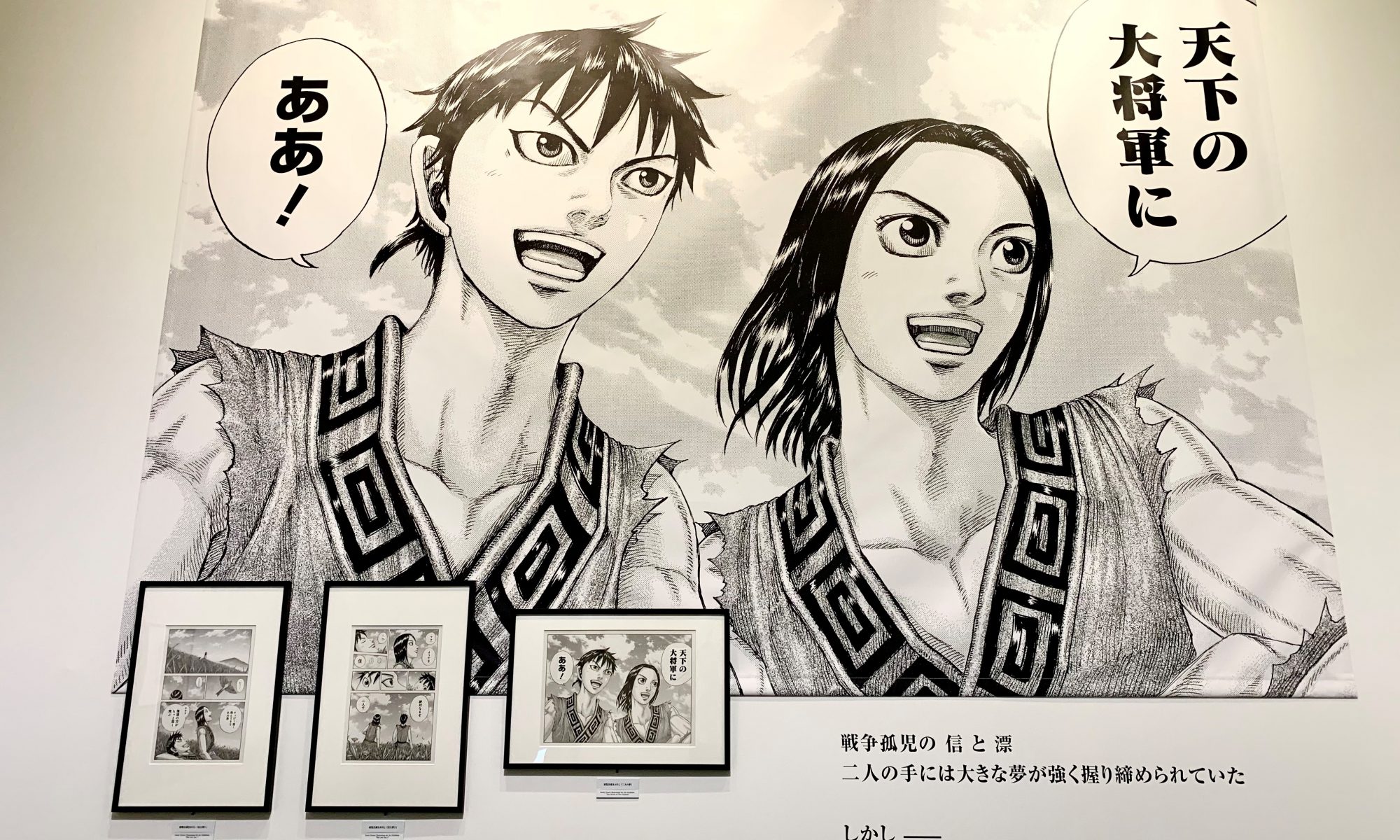Tokyo National Museum
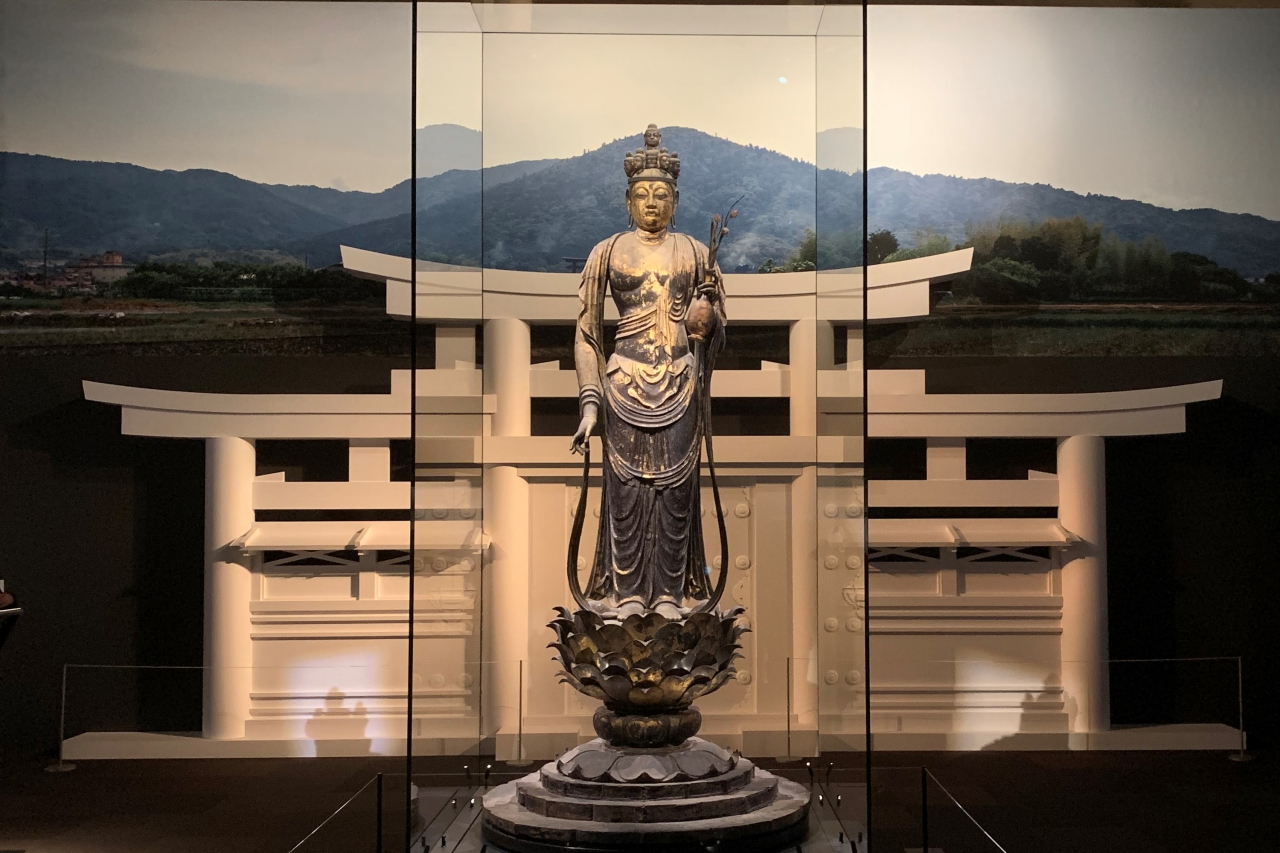
From June 22nd (Tuesday) to September 12th (Sunday), 2021, a special exhibition “National Treasure Seirinji Eleven-faced Kannon-Miwayama Faith Mihotoke” is being held at the Tokyo National Museum in Ueno, Tokyo. is.
This exhibition attracts attention as the national treasure “Eleven-faced Guanyin Bodhisattva Statue”, which is said to be the masterpiece of Japanese sculpture due to its exceptional beauty, is exhibited outside Nara Prefecture for the first time in history. Since I participated in the press preview, I will report on the situation at the venue.
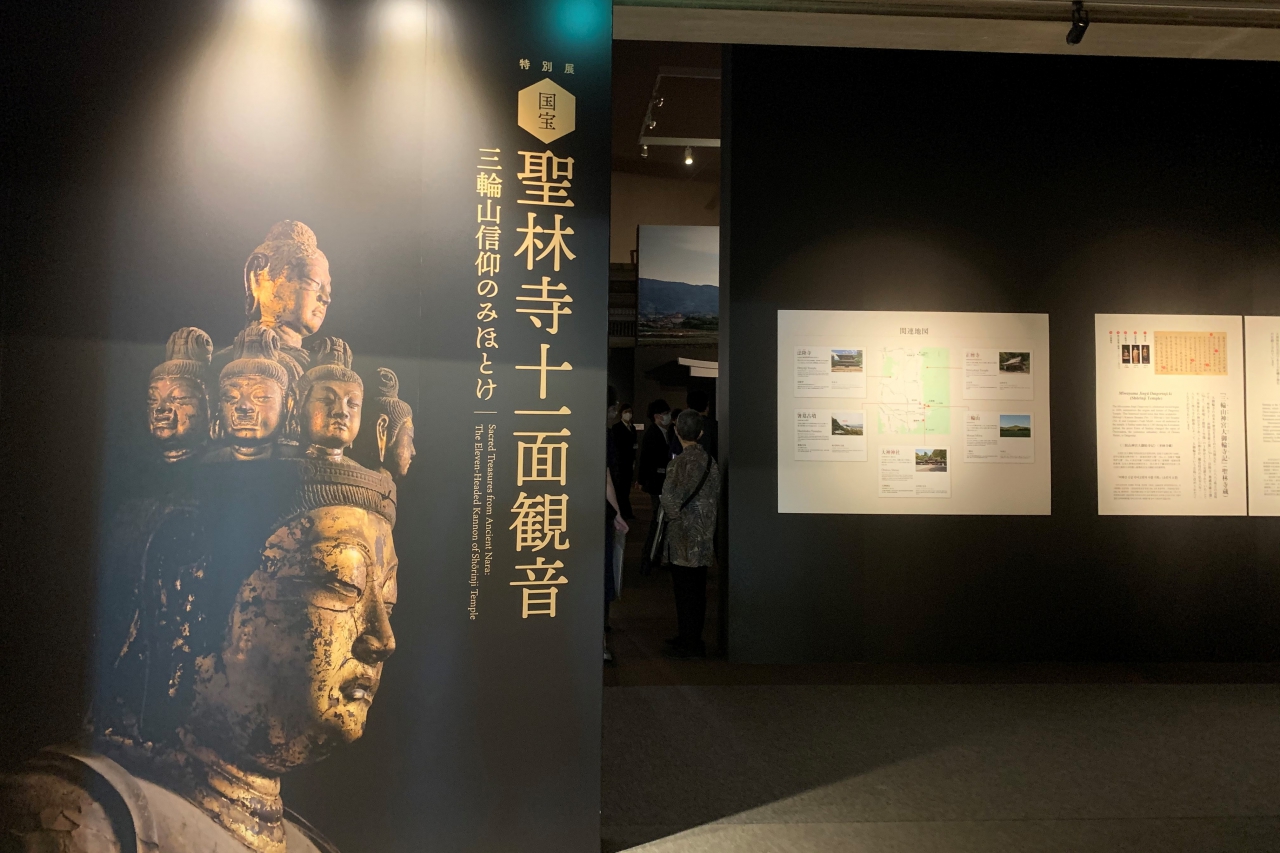
Buddha statues related to Oomiwa Shrine reunited for the first time in about 150 years!
The national treasure “Eleven-faced Kannon Bosatsu Statue”, which is the main character of this exhibition, is owned by Shorinji Temple in Sakurai City, Nara Prefecture, but until the Edo period, it was enshrined at Oomiwa Shrine in the same city, not at Shorinji Temple. Did you know that it was done?
Oomiwa Shrine with Mt. Miwa as the deity that conveys the ancient Japanese belief in nature to the present day. In the Nara period, the introduction of Buddhism promoted Shinto-Buddhist training, and Oomiwa-ji Temple (renamed to Oomiwa-ji Temple in the Kamakura period) was built in the precincts of Oomiwa Shrine, and many Buddhist statues are now enshrined.
However, when the Meiji government’s Shinbutsu bunri decree caused a wave of abolition of Buddha, Daimiwaji became an abandoned temple. Buddha statues are also forced to move to nearby temples such as Shorinji Temple, which they have a close relationship with.
This exhibition includes the national treasure “Eleven-faced Kannon Bodhisattva statue”, the national treasure “Jizo Bodhisattva statue” (Horyuji temple collection), “Nikko Bodhisattva statue” and “Moonlight Bodhisattva statue” (both are Shokei temple collection). The Buddhist statues enshrined at Rinji are exhibited together in the form of reunion for the first time in about 150 years.
At the same time, we will introduce materials that tell the story of the natural beliefs of Oomiwa Shrine and ancient rituals, as well as excavated items from the Mt. Miwa forbidden land.

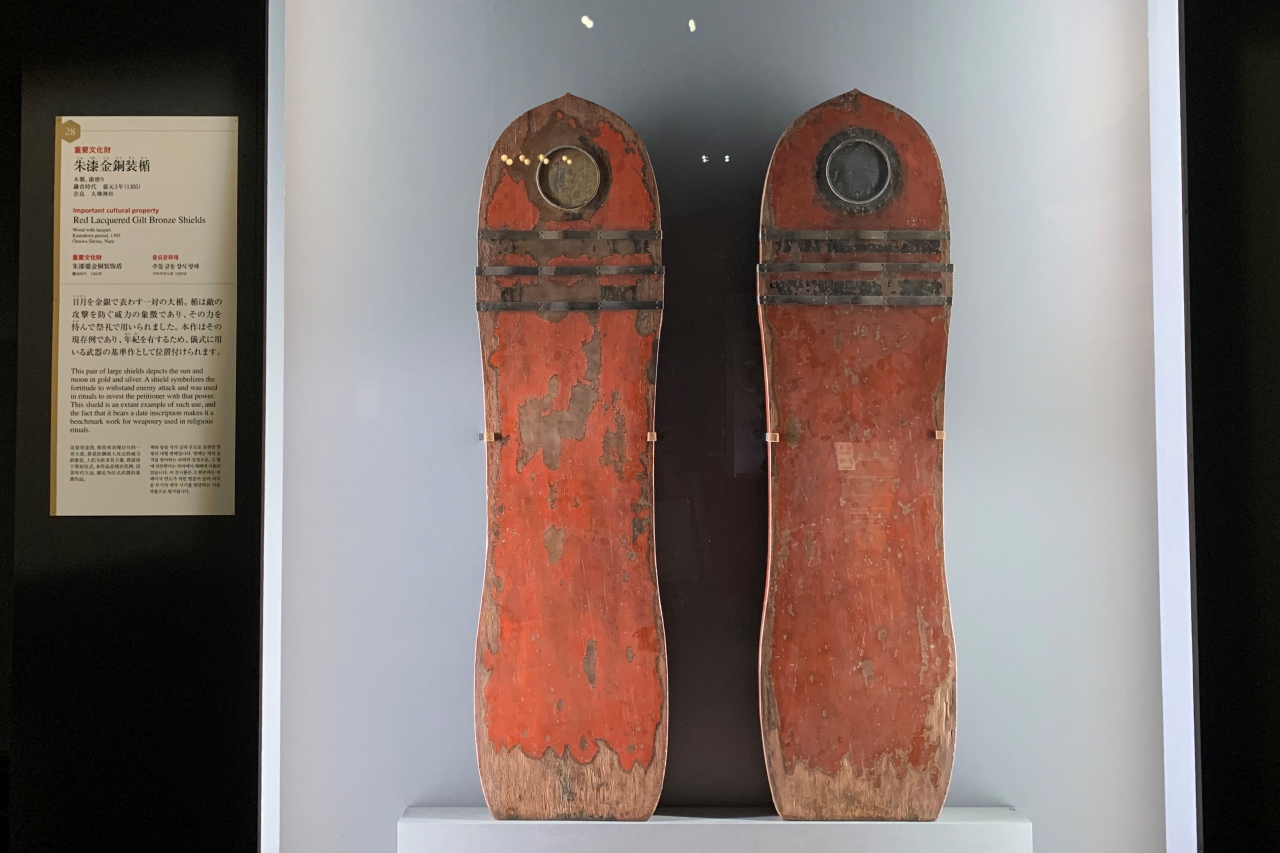
Eleven-faced Kannon to enjoy 360 degrees from various angles

The national treasure “Eleven-faced Kannon Bodhisattva Statue” is settled in the center in a clean atmosphere. Behind the statue is a reproduction of the three torii gates of Oomiwa Shrine. It is not the main shrine that continues from the torii gate, but Mt. Miwa, which visually conveys the form of natural beliefs at Oomiwa Shrine.

Eleven-faced Kannon, as the name implies, has 11 faces.
In India, the number “10”, which means all directions, is combined with the main body surface to make 11 faces, but in Japan, the main body face + 11 faces is common. The national treasure “Eleven-faced Kannon Bodhisattva Statue” is also the latter.
The 11 faces of the crown overlooking all directions have individuality, and the 3 front faces are the “Bodhisattva face” with a gentle expression. The “shinnu side” looks like an angry face on the left side (right side when facing the front) when viewed from the statue. The right side (left side when facing the front) when viewed from the statue is the “gejoshutsu side” where the fangs are exposed. “Laughing face” with a big laugh on the back side. And it is the “top Buddha face” in the center.

The current national treasure “Eleven-faced Kannon Bodhisattva Statue” has lost three sides. Therefore, unfortunately, it is not possible to check only the “laughing face”, but since the venue is arranged so that you can watch it from anywhere in the front, back, left and right, it is a nice point to enjoy all the existing faces with the naked eye.
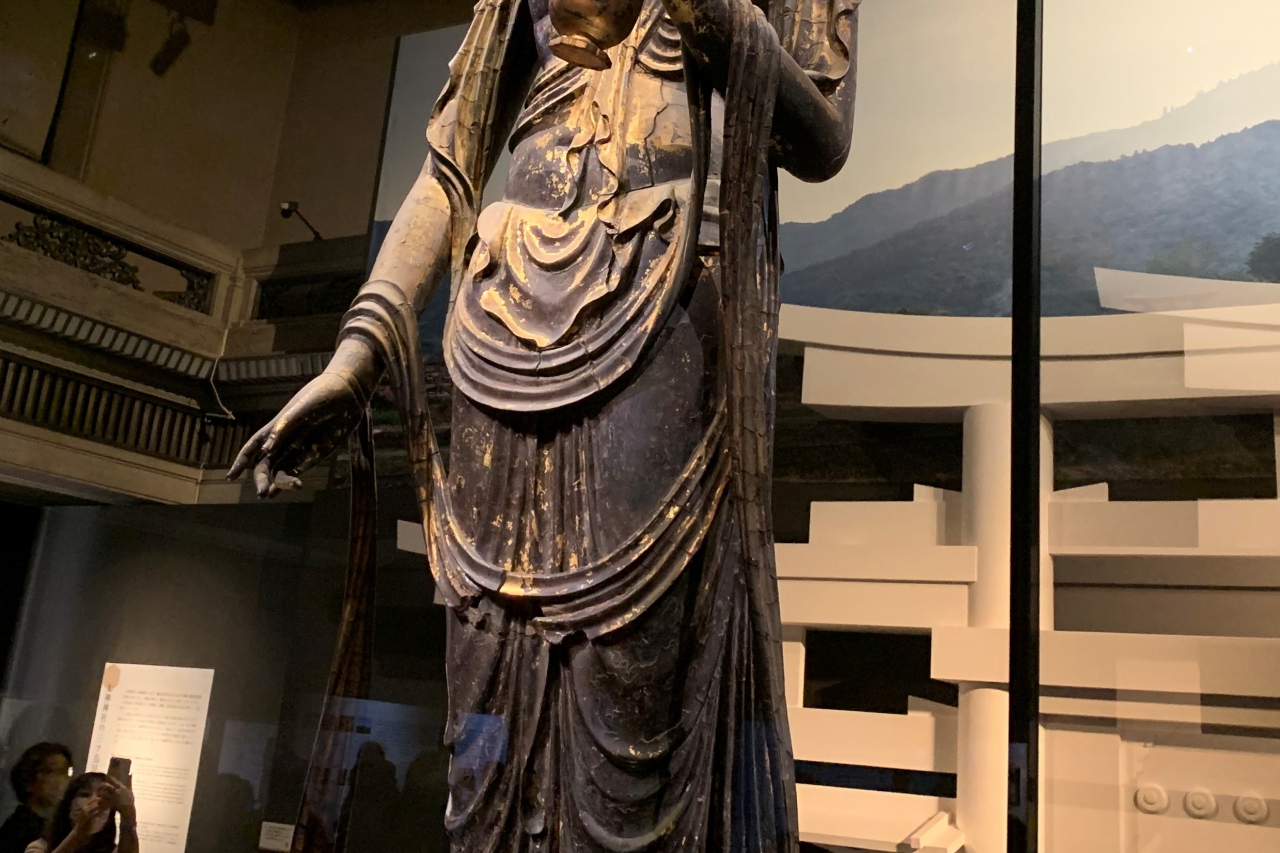
Most of the pre-modern Buddhist statues that exist in Japan are made of wood, but in the Nara period and around the latter half of the 8th century, a technique called dry lacquer was used for production. This statue is also one of those made by “Kishin dry lacquer ware”, which is made by molding lacquer and wood powder kneaded material called Kokuso lacquer on the wood core.
Wooden lacquer is said to be suitable for realistic expression because it is made by raising lacquer instead of scraping it. In this statue, the loose curves of the folds of the heavenly garment that seem to be covered with wind, the tension of the flesh, the undulations of the eyelids that make you feel the presence of the eyeballs, and the orderly appearance of the hair muscles are expressions unique to wooden lacquer. Is the highlight.

From the side, you can see the slender proportions of 8 life, the thickness of the chest, and how to place the center of gravity. The posture with the head of a solemn face slightly forward seems to be trying to capture the appearance of people firmly.
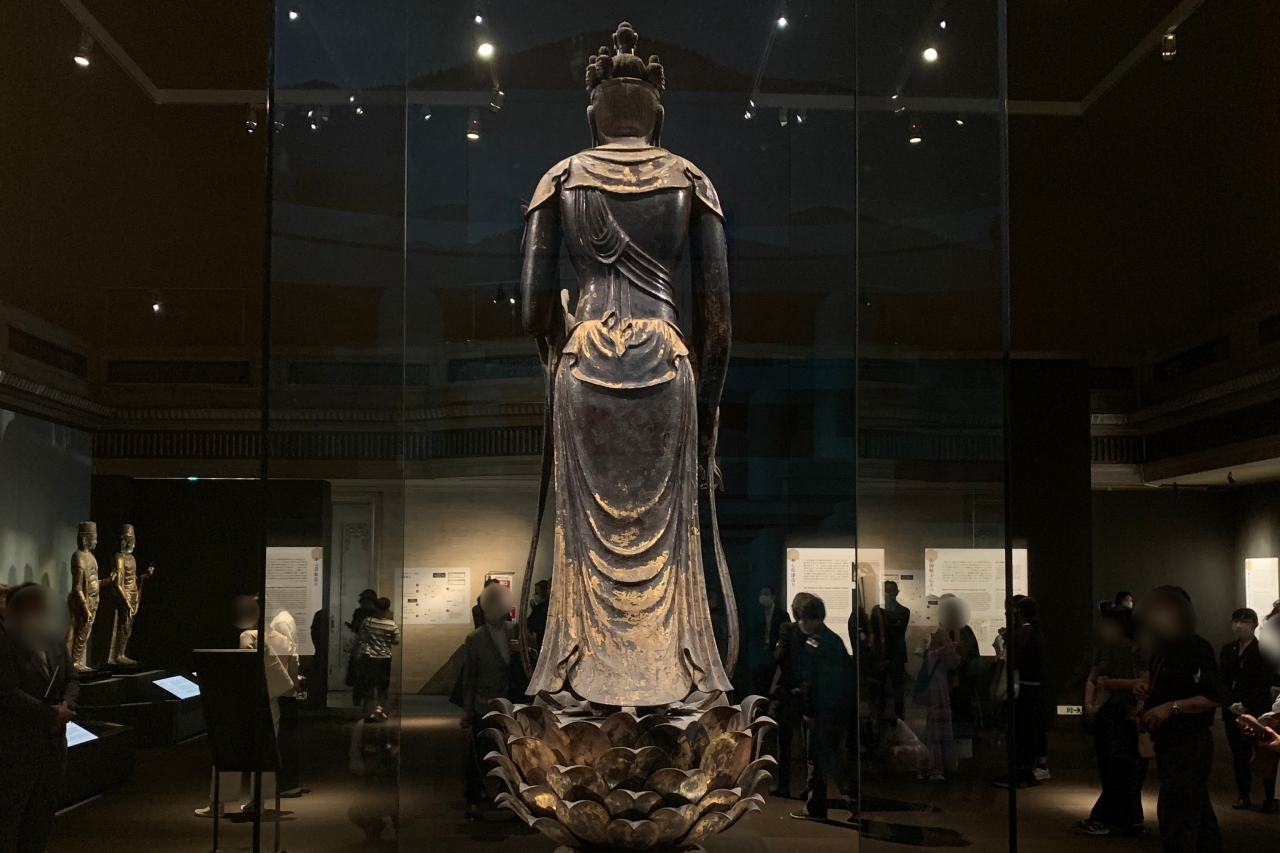
The rear view is a gem of beauty, not to mention the smoothness of the back, but especially the graceful appearance that the curve of the clothes from the waist to the legs is fascinating is a must-see. The contrast between the gold leaf that has been peeled off in places and the glossy black color of the ground creates a shadow with an atmosphere.

If you look closely at the details, you will also be fascinated by the gentleness of the fingers of your left hand holding the treasure bottle and your right hand lowered. The pedestal with a lotus flower motif also has the gorgeousness of Tenpyo art. It makes me realize that the reputation of being “the masterpiece of Japanese art” is not an exaggeration.

In addition, a halo that visually expresses the halo of the gods and Buddha is also on display. Nowadays, most of it is lost except for the shaft part, but it is speculated that it was originally a halo that engraves a triple sphere and arabesque. The splendor of the past days is remembered.
Introducing other exhibited works

The national treasure “Jizo Bosatsu Statue”, which was once placed next to the eleven-faced Kannon at Omiwaji Temple, is a Buddhist statue carved from a single piece of wood except for the hands of both hands. The thick body is full of realism, as if a single tree were standing there.
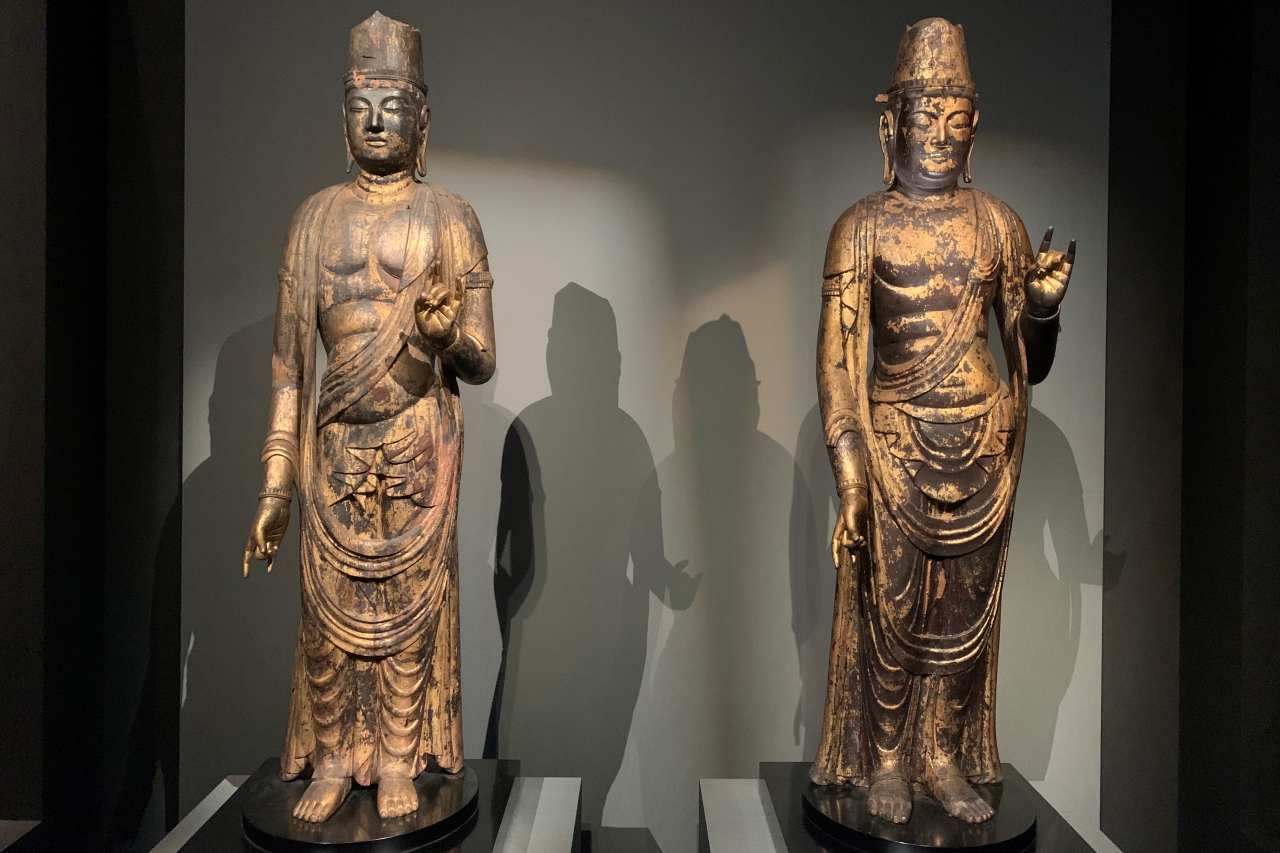
The “Nikko Bosatsu Statue” and “Moonlight Bosatsu Statue” look exactly like each other, but it is interesting that the materials, structural techniques, and styles are different, and it seems that they were not originally one tool. The Nikko Bodhisattva has a large nose, and the Moonlight Bodhisattva has a long and gentle expression, and the area around the chin looks refreshing.

In this exhibition, the ones excavated at Mt. Miwa Forbidden Land and Yamanokami Heritage are also exhibited, but most of them are imitations in the shape of tools used for some kind of ritual. The most eye-catching are the stone products and earthenware that are shaped like the utensils related to sake brewing.
It was interesting to see that the brewing beliefs of Oomiwa Shrine, which remains to this day, can be traced back to the Kofun period from the existence of excavated items, assuming that Omononushi, the deity of Oomiwa Shrine, is the god of sake. ..
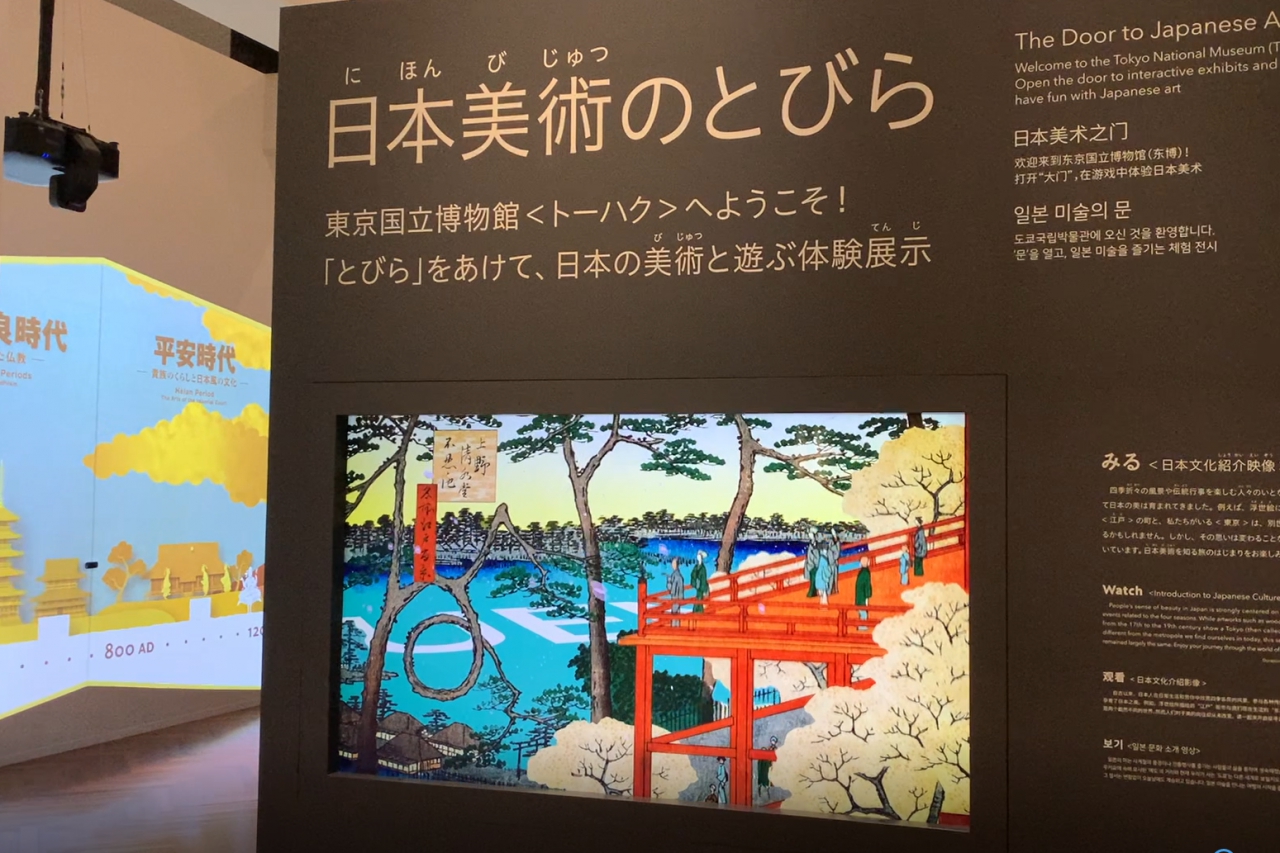

The special exhibition “National Treasure Shorinji Eleven-faced Kannon-Mt. Miwa Faith Mihotoke” will be held until September 12, 2021 (Sun).
At the same time as the opening of this exhibition, a new permanent experience exhibition called “Japanese Art Tobira” was released in the special 3 rooms of the main building of the Tokyo National Museum. If you move your hand in front of a huge screen where you can learn about the history of Japanese art, you can experience interactive experiences such as rotating the displayed pop-up of Japanese art and turning pages. You can also appreciate masterpieces such as “Wind” and “Flowering Plants of Summer”.
Advance reservations are required, but the admission fee for the special exhibition will be included as it is, so why not take a tour together?
Outline of the special exhibition “National Treasure Shorinji Eleven-faced Kannon-Mt. Miwa Faith Mihotoke” * This exhibition requires advance reservation (reserved-seat ticket). Please check the official exhibition website for details.
| Session | June 22nd (Tuesday) -September 12th (Sunday), 2021 |
| Venue | Tokyo National Museum Main Building Special 5 Rooms |
| Opening hours | 9:30 am to 5:00 pm |
| closing day | Monday (However, it will be open on August 9th) |
| Admission fee | Advance reserved-seat ticket General 1,400 yen, college students 700 yen, high school students 400 yen, junior high school students and younger free
For other details, please visit the official exhibition website ⇒ https://tsumugu.yomiuri.co.jp/shorinji2020/tickets.html |
| Organizer | Tokyo National Museum, Yomiuri Shimbun, Agency for Cultural Affairs, Japan Arts Council |
| Exhibition official website | https://tsumugu.yomiuri.co.jp/shorinji2020/ |
Ueno Royal Museum
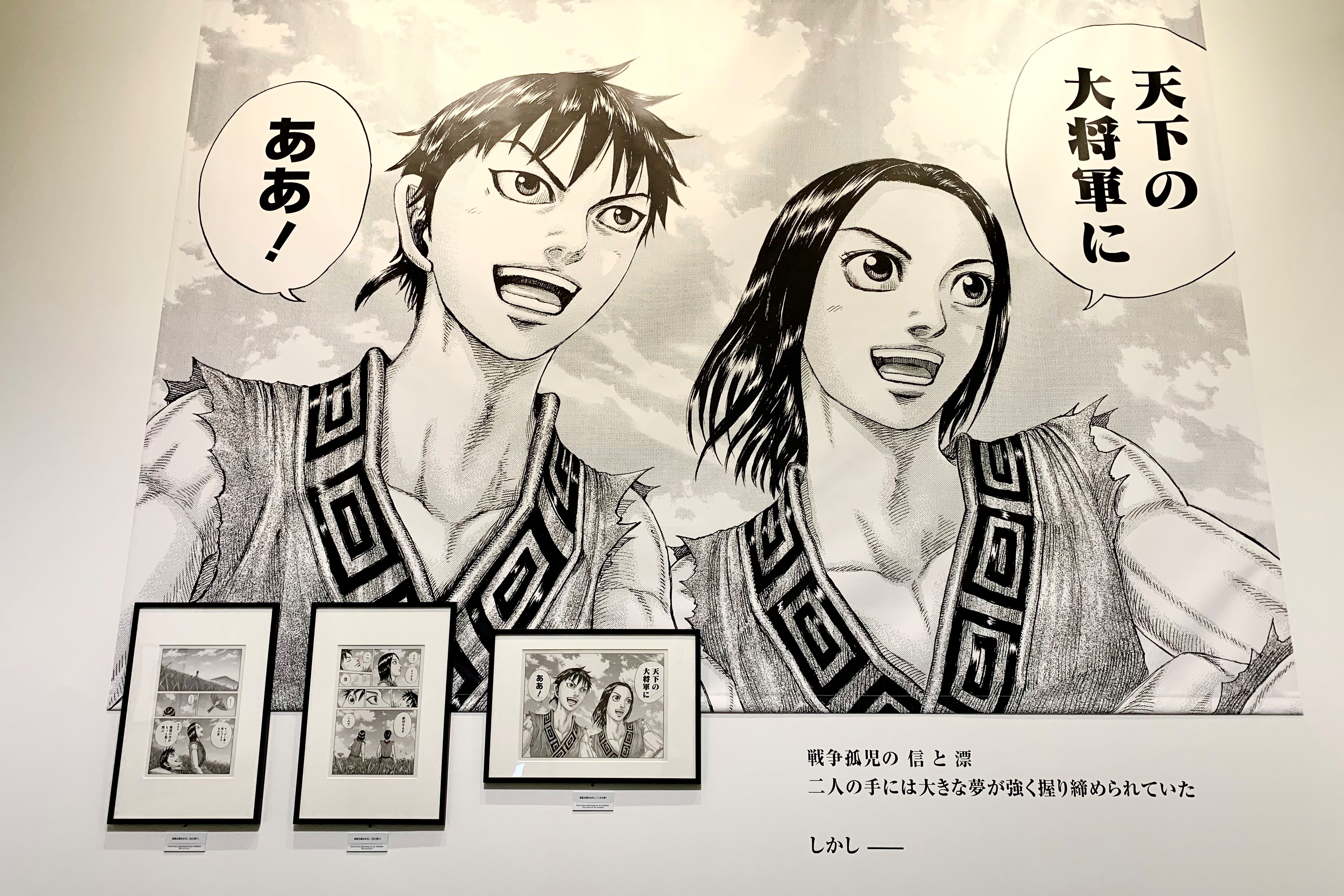
Exhibition of Yasuhisa Hara original of the cartoon "Kingdom," "Kingdom Exhibition – Shin -" is, is being held at the Ueno Royal Museum in Tokyo Ueno. * The session is from June 12th (Sat) to July 25th (Sun), 2021.
"Kingdom Exhibition-Shin-" created under the full supervision of the author



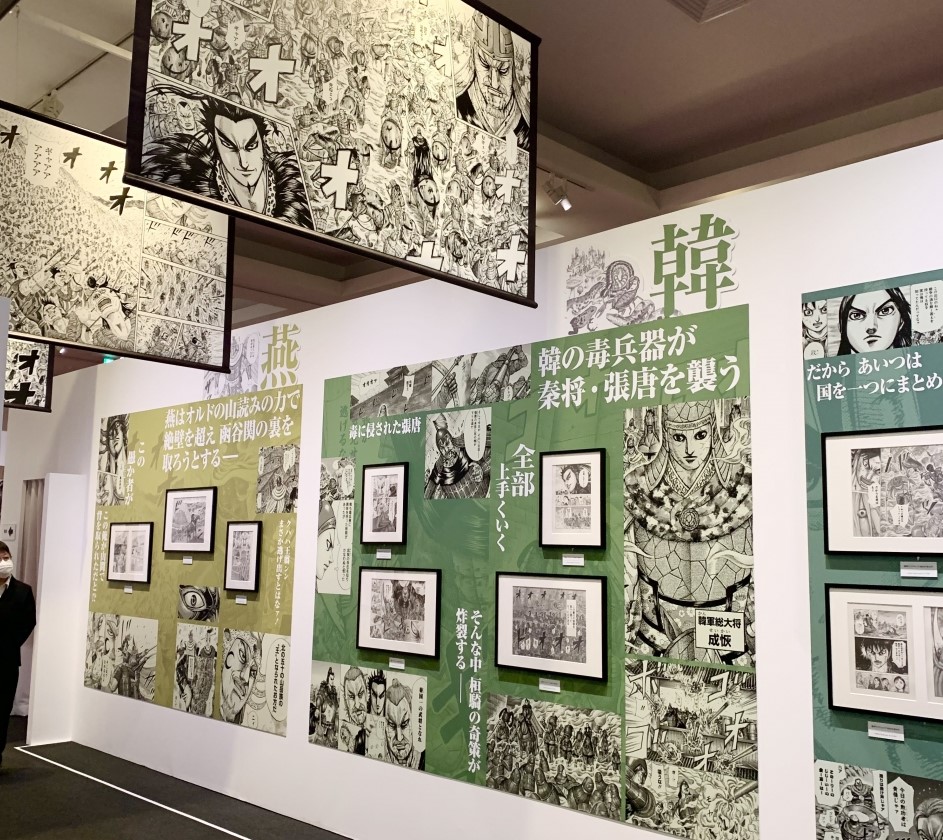
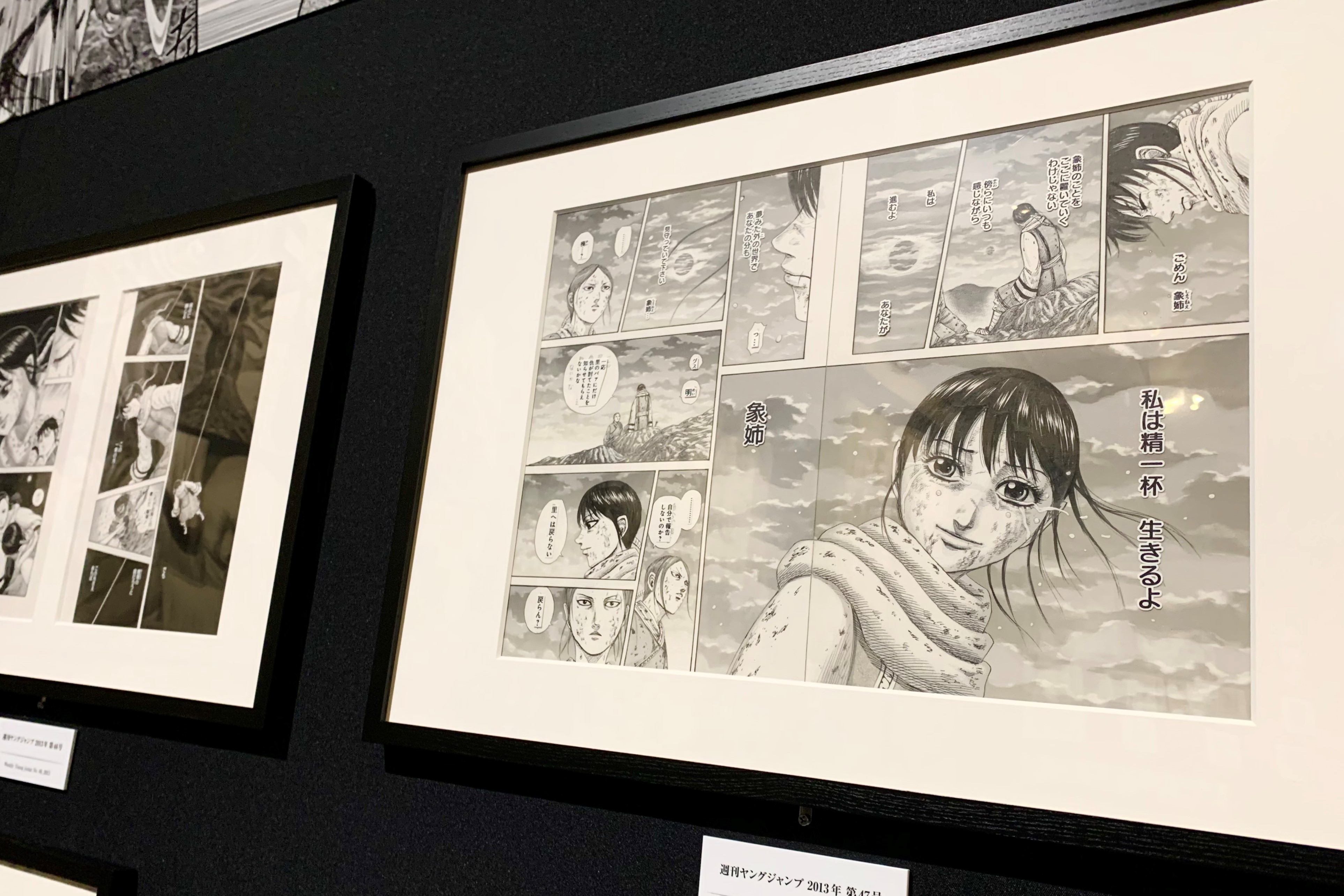
The popular manga "Kingdom" serialized in "Weekly Young Jump" (Shueisha) is set in China during the Warring States period in the spring and autumn, and is a former servant boy, Shin, who aims to become a general in the world, and Qin, who later becomes Qin Shi Huang. This is a story about the young king, Eisei, aiming to unify China.
This "Kingdom Exhibition-Shin-" was planned to commemorate the 15th anniversary of the serialization of "Kingdom". This is the largest exhibition of original paintings in history, where you can immerse yourself in the world of powerful works.
Under the full supervision of the author, Mr. Hara, the story of the main character, Shin, is reconstructed, and the story of encounters, battles, and farewells from the first episode "The Boy With No Name" to the 438th episode "The Time of Yuhi" is 400. It is a content that will be followed with a handwritten original picture with more than a point and a huge graphic.
20 original drawings! Introducing the exhibition contents and venue of "Kingdom Exhibition-Shin-"
This exhibition is divided into areas consisting of Chapters 0 to 13 + ending.

In Chapter 0 "The Boy With No Name", which introduces the beginning of Shin's story, Shin and his best friend Hyo, who were orphans from the war, talk about their dreams of becoming a general in the world and the original picture of the farewell scene is exhibited. It has been. In this exhibition, 20 original drawings drawn for this exhibition are exhibited, but about 1/3 of them are concentrated in this chapter 0! Newly beautifully drawn faith and days spent drifting … I feel Mr. Hara's strong commitment.

In Chapter 1, "Battle of the Dakan Heigen", Shin's first battlefield is fully reproduced with a graphic panorama based on the newly drawn original picture and battle BGM.
In the following Chapter 2, "The Phantom Bird of Qin," a huge original drawing (Japanese paper panel) of Qin's general, Ouki, who meets Shin in the "Battle of the Snake Sweet Plains" and chases his back. Will show up. The size is about 3m in height and about 1.5m in width, which is a powerful score!
In the 66th episode of the original story, when I first met the royal knight, I was overwhelmed by the size of his existence, saying, "This … this guy … is too big to solve!" One can look up at the royal knight from the same perspective as Shin.

In Chapter 3, "Mayo Defense Battle," which focused on the activities of Shin's unit, which was named "Hishin Corps" by the royal horse, Zhao's enemy general, Feng, had a slight gap after the fierce battle. The highlight is that it expresses one of the most famous scenes in which Shin defeated) with a three-dimensional structure.


And the exhibition is Chapter 4 "Pang Nuan and Pang Nuan", which pursues the death battle between the royal knight and the enemy, Pang Nuan, and the fifth, which shows the final scene of the royal knight only with a series of original drawings. We will continue to Chapter "Inheritors" and Chapter 6 "Aiming for Generals", which introduces those who have emerged in Qin.
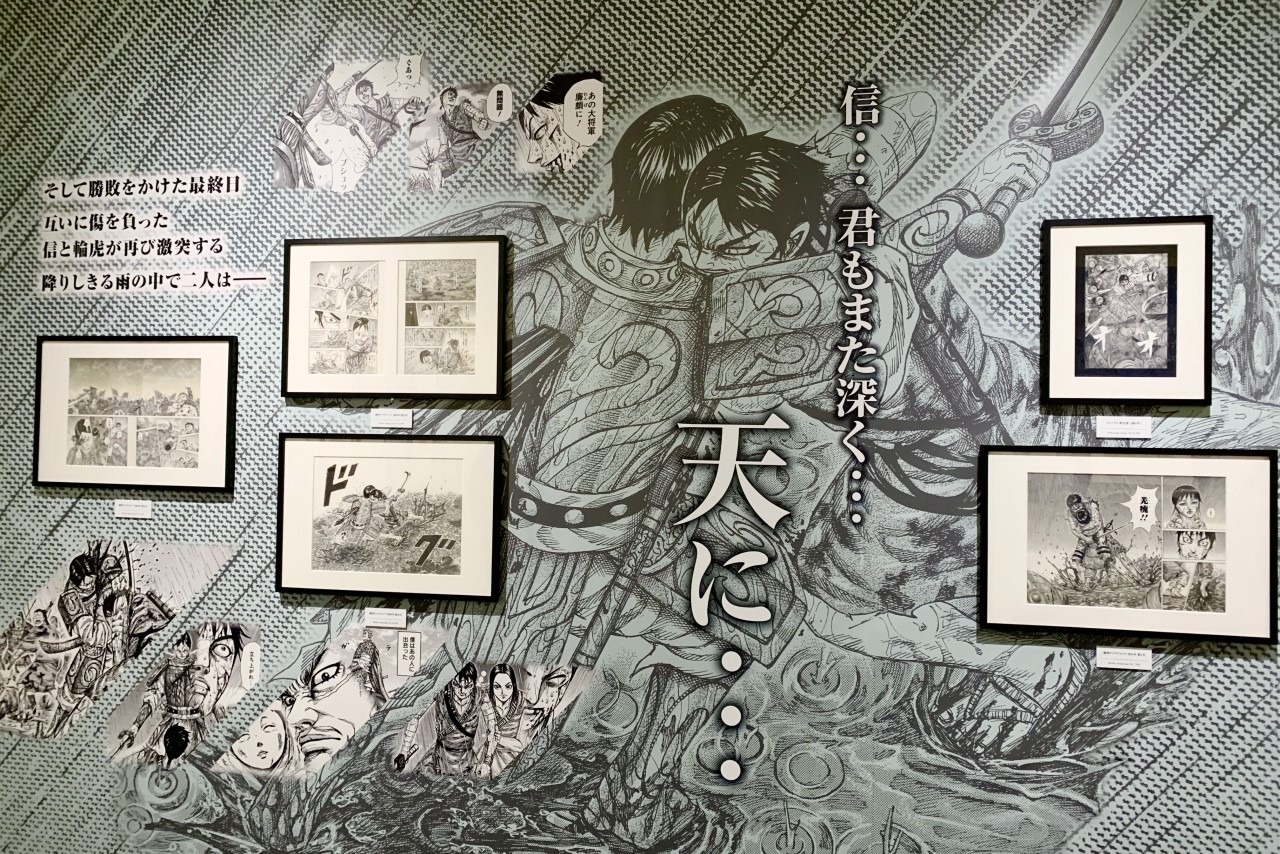

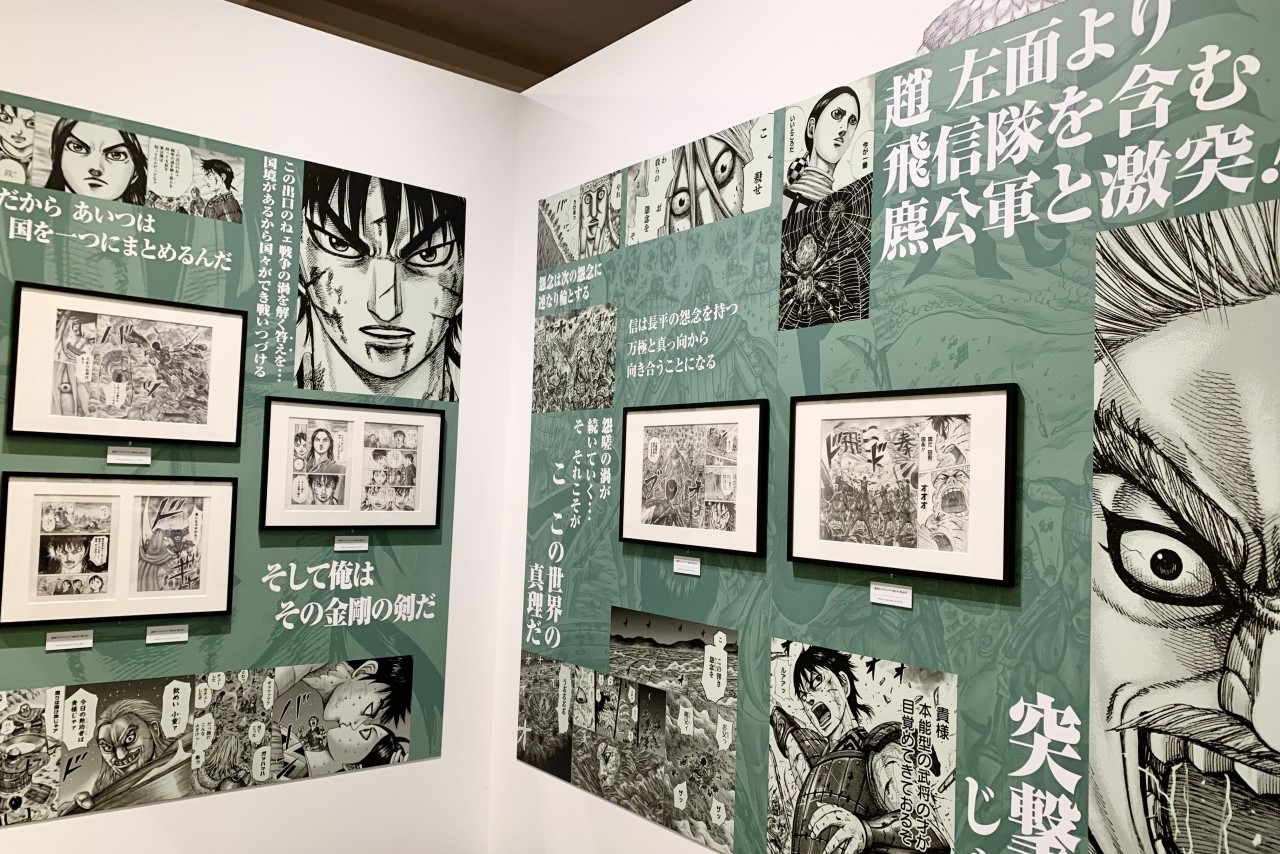
The battle of Shin is extremely fierce, with Chapter 7 "Battle of Sanyo" and Chapter 8 "Battle of Kankokukan". In particular, the exhibition of "Battle of Hakotani Seki", in which the five countries of Wei, Zhao, Han, Yan, and Chu became joint forces and invaded Qin and despaired many readers, is an enemy country that changes rapidly in 15 days. The highlights of each battlefield are tightly packed and very impressive!

The battle between Qin and the combined forces involves the exhibitions in Chapters 9 and 10. Chapter 9 "Great Flame", which expresses the burning flames of the fiery battle of Lord Biao, who was the first battlefield commander for Nobu, on the red wall, is also exciting, but it was ridiculed. In the final phase, Chapter 10 "Battle of Buds" introduces the battle in "Sai", which has no end if you lose.
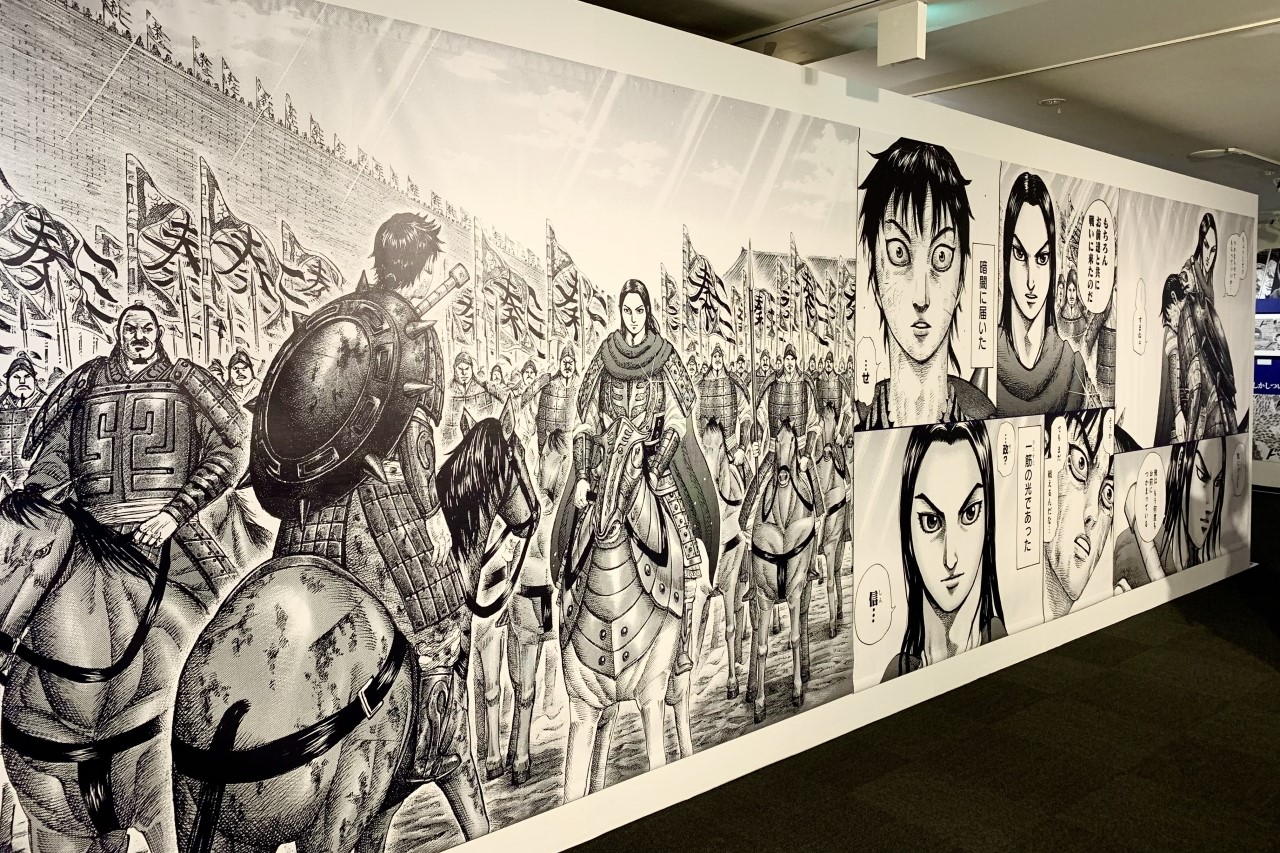
Looking sideways from the original picture depicting the figure of Shin, who was exhausted by repeated death battles, lost Lord Biao, and was about to break his heart, he was confident that he came to the dead ground despite being a king. The scene that appears in front of you appears with a graphic on the entire wall. It had a presence as if Shi Huang was right in front of him, and it was a nice production where he could experience the light that reached the darkness and the impression that Shin received.
Chapters 11-12 are a moving gem arrangement
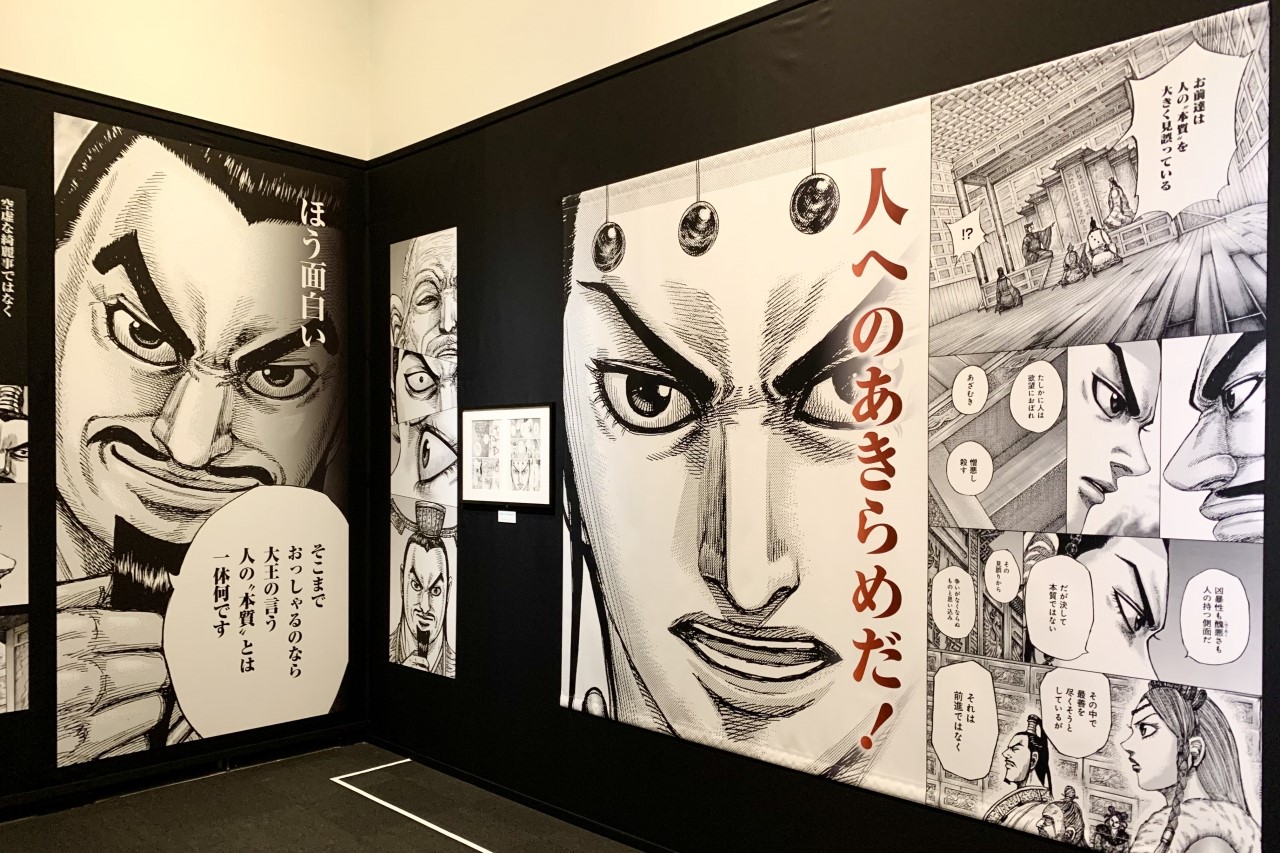
The original drawings have been arranged in chronological order up to Chapter 10, but at the end of the exhibition, after Chapter 11, it is an original development only for this exhibition.
From Chapter 11 "Questions of Lu Buwei" to Chapter 12 "The essence of human beings is light", the nation of Qin fighting for supremacy and hegemony, which was drawn in episodes 423 to 427 of the original story.・ Based on the questions and answers about the pros and cons of unifying China by Lu Buwei.
War is an unmistakable manifestation of the essence of human beings, and the background of why Qin Shi Huang, who strongly denies Lu Buwei's idea that war will not disappear, "the essence of human beings is light" came to that idea. Is introduced in a vast space.
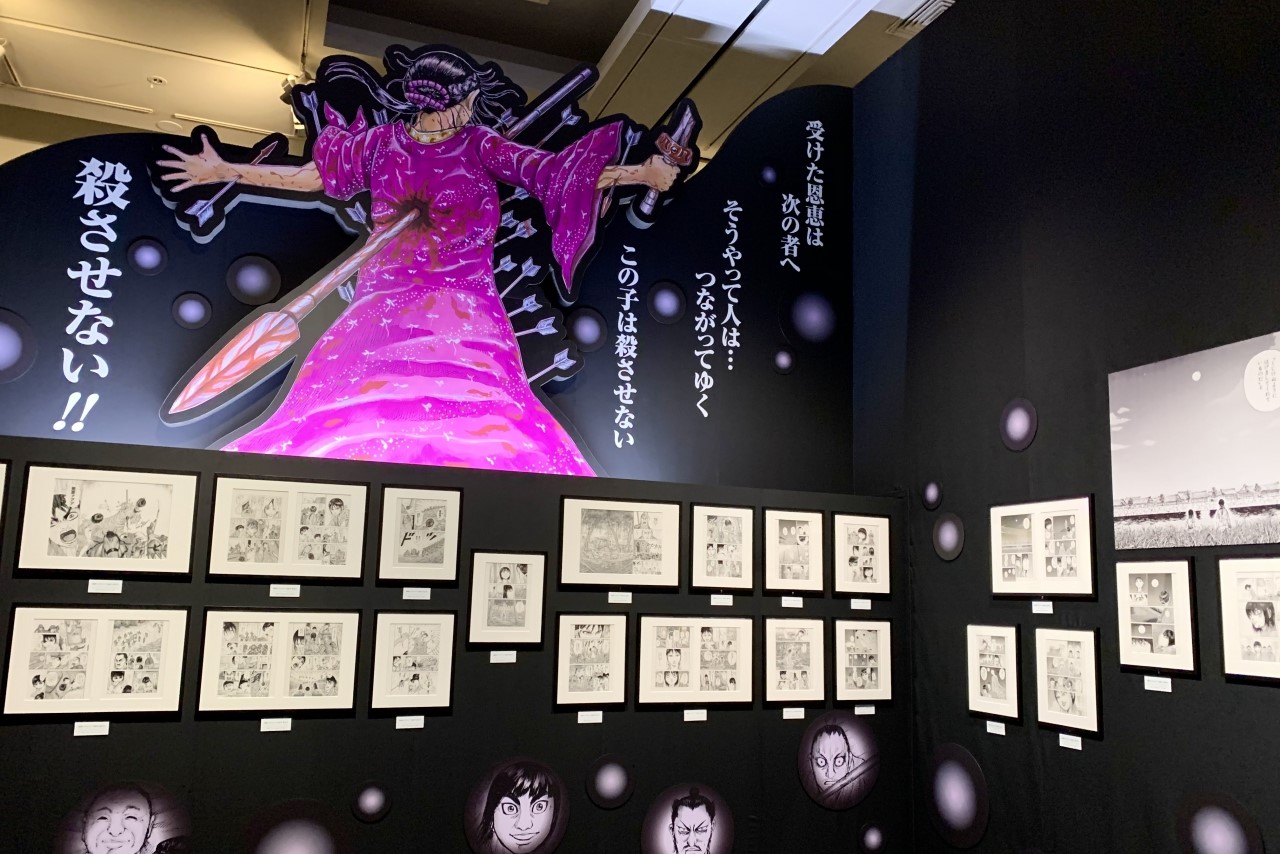

A woman named Shi Huang who saved her childhood politics, drifting, royal knights and Lord Biao, and unnamed people. Impressive scenes of characters who have met, supported, entrusted their thoughts, and died by shining the light inside themselves appeared like a magic lantern, shaking the tear glands of the original reader. I will.
The arrangement that makes it more dramatic without spoiling the charm of the famous scene that was the most exciting in the original is excellent. It may be said that this chapter is the biggest highlight of this exhibition.
Color originals and one-shot names
The final chapter, Chapter 13, "The Time of Yuhi," features a remake of the future of Shin, who became a shogun, drawn at the beginning of the first episode. The story exhibition ends when Shin and Shi Huang, who have overcome their harsh fate, take a new step.



At the end of this exhibition, the "ending" that core fans will be pleased with awaits the viewers. "Bonus original picture selection" that introduces famous scenes that could not fit in each chapter with author's comments, color original pictures including newly drawn exhibition key visuals, one-shot "golden wings" name that can be said to be a prototype of "Kingdom", Valuable items such as rough sketches were lined up.
"Kingdom Exhibition-Shin-" where you can fully enjoy the writing condition of the original drawings, such as the realistic battle scenes, which is one of the greatest attractions of "Kingdom", and the facial expressions of characters full of vitality.
This exhibition, where you can walk with the feeling of "reading" rather than seeing, should be able to enjoy the story of Shin from the beginning with a fresh feeling, regardless of whether you are a light fan or a core fan. Please come and visit us.
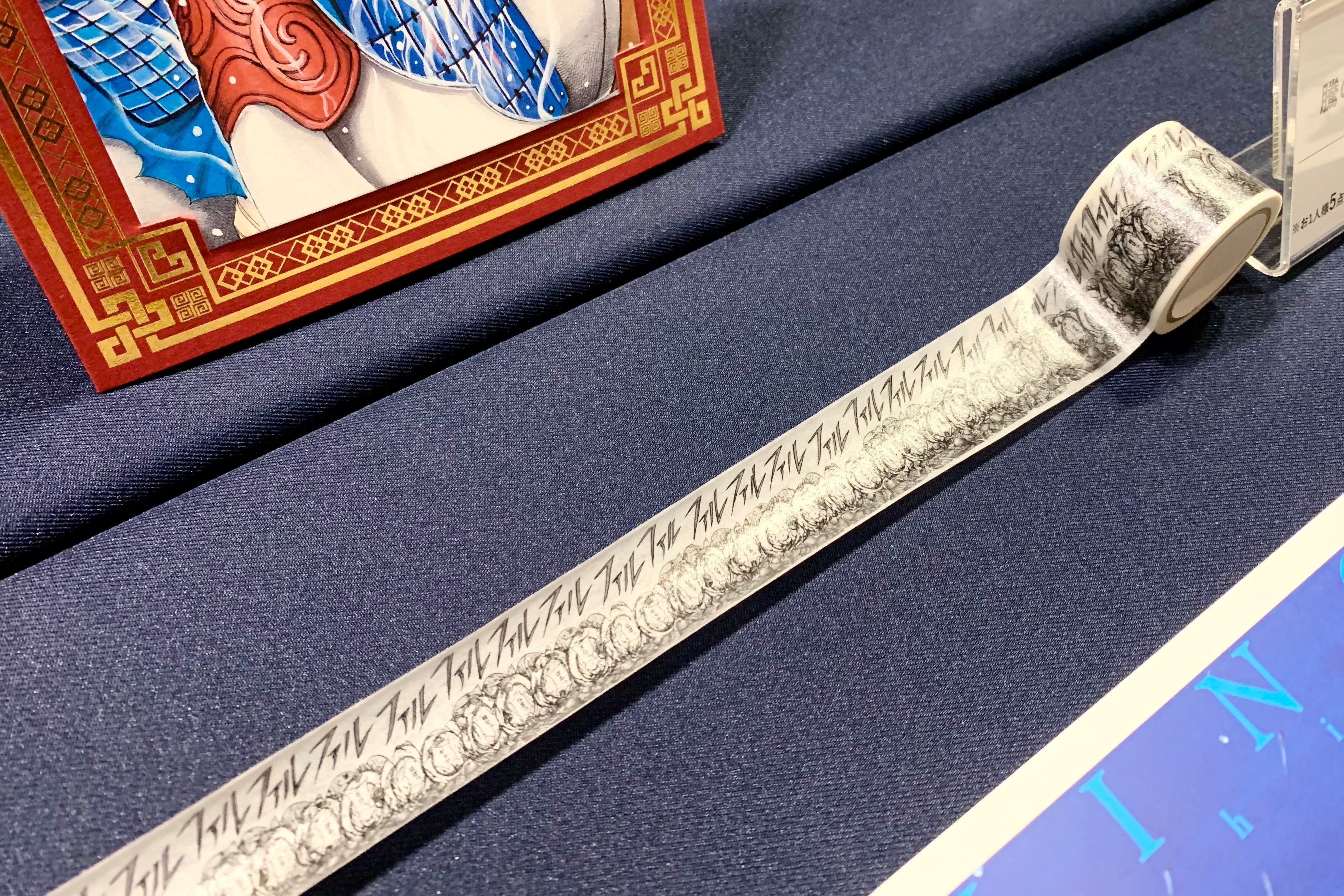
Outline of "Kingdom Exhibition-Shin-"
| Session | June 12th (Sat) -July 25th (Sun), 2021 |
| Venue | Ueno Royal Museum |
| Opening hours | 10: 00-20: 00 * Last admission is 1 hour before closing |
| Admission fee | All-day date and time designation system Please check the official website for details. https://kingdom-exhibit.com/ticket |
| Organizer | Shueisha, Asahi Shimbun |
| Sponsorship | Kyodo Printing, Lawson Ticket |
| Inquiry | 050-5541-8600 (Hello dial from 9:00 to 20:00 all day) |
| Official site | https://kingdom-exhibit.com/ |

